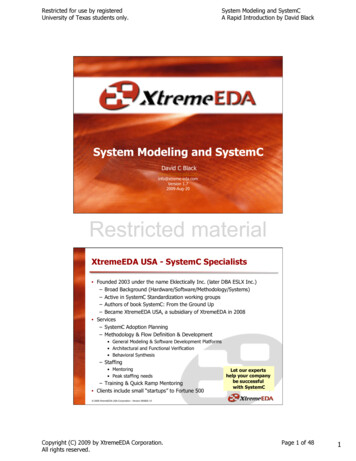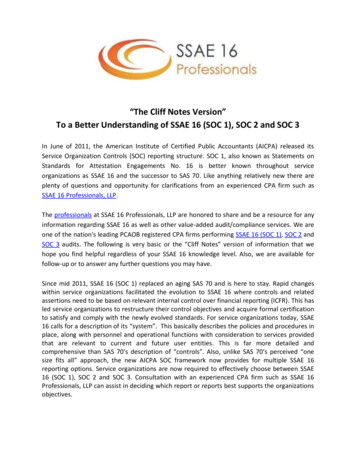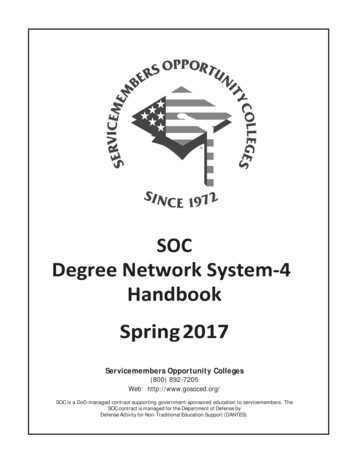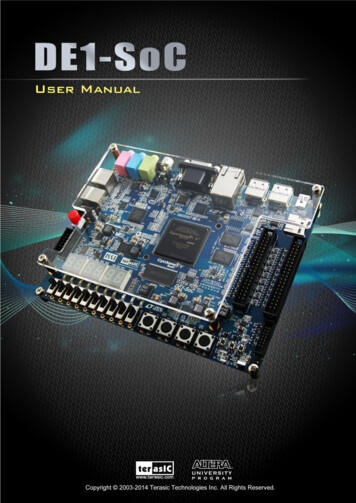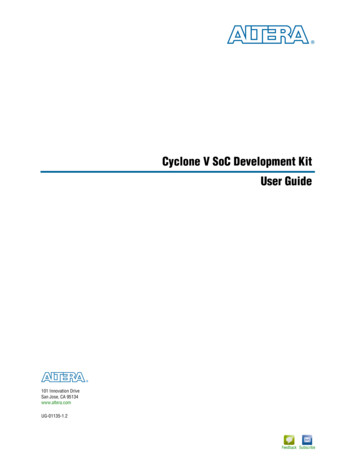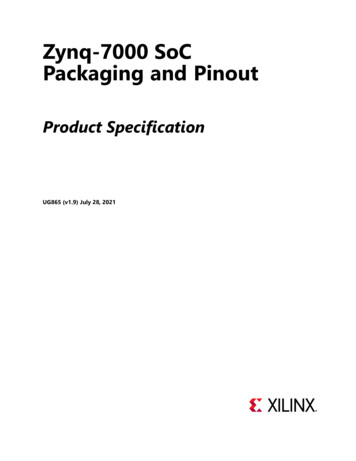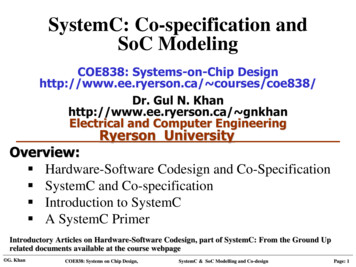
Transcription
SystemC: Co-specification andSoC ModelingCOE838: Systems-on-Chip Designhttp://www.ee.ryerson.ca/ courses/coe838/Dr. Gul N. Khanhttp://www.ee.ryerson.ca/ gnkhanElectrical and Computer EngineeringRyerson UniversityOverview: Hardware-Software Codesign and Co-Specification SystemC and Co-specification Introduction to SystemC A SystemC PrimerIntroductory Articles on Hardware-Software Codesign, part of SystemC: From the Ground Uprelated documents available at the course webpage G. KhanCOE838: Systems on Chip Design,SystemC & SoC Modelling and Co-designPage: 1
Hardware-Software CodesignCo-design of Embedded Systems consists of thefollowing parts: Co-SpecificationDeveloping system specification that describes hardware,software modules and relationship between the hardwareand software Co-SynthesisAutomatic and semi-automatic design of hardware andsoftware modules to meet the specification Co-Simulation and Co-verificationSimultaneous simulation of hardware and software G. KhanCOE838: Systems on Chip Design,SystemC & SoC Modelling and Co-designPage: 2
HW/SW Co-Specification Model the Embedded system functionality froman abstract level. No concept of hardware or software yet. Common environmentSystemC: based on C . Specification is analyzed to generate a taskgraph representation of the systemfunctionality. G. KhanCOE838: Systems on Chip Design,SystemC & SoC Modelling and Co-designPage: 3
Co-Specification A system design language is needed to describe thefunctionality of both software and hardware. The system is first defined without making anyassumptions about the implementation. A number of ways to define new specificationstandards grouped in three categories: SystemC - an open-source library in C that provides amodeling platform for systems with hardware and softwarecomponents. G. KhanCOE838: Systems on Chip Design,SystemC & SoC Modelling and Co-designPage: 4
SystemC for Co-specificationOpen SystemC Initiative (OSCI) 1999 by EDA vendersincluding Synopsys, ARM, CoWare, Fujitsu, etc. A C based modeling environment containing aclass library and a standard ANSI C compiler. SystemC provides a C based modeling platform forexchange and co-design of system-level intellectualproperty (SoC-IP) models. SystemC is not an extension to C SystemC 1.0 and 2.1, 2.2 and 2.3.3 versionsIt has a new C class library G. KhanCOE838: Systems on Chip Design,SystemC & SoC Modelling and Co-designPage: 5
SystemC Library ClassesSystemC classes enable the user to Define modules and processes Add inter-process/module communication throughports and signals.Modules/processes can handle a multitude of data types:Ranging from bits to bit-vectors, standard C typesto user define types like structuresModules and processes also introduce timing,concurrency and reactive behavior. Using SystemC requires knowledge of C/C G. KhanCOE838: Systems on Chip Design,SystemC & SoC Modelling and Co-designPage: 6
SystemC 2.0 Language Architecture G. KhanCOE838: Systems on Chip Design,SystemC & SoC Modelling and Co-designPage: 7
SystemC 2.0 Language Architecture All of the SystemC builds on C Upper layers are cleanly built on top of the lower layers The SystemC core language provides a minimal set ofmodeling constructs for structural description, concurrency,communication, and synchronization. Data types are separate from the core language and userdefined data types are fully supported. Commonly used communication mechanisms such assignals and FIFOs can be built on top of the core language.The MOCs can also be built on top of the core language. If desired, lower layers can be used without needing theupper layers. G. KhanCOE838: Systems on Chip Design,SystemC & SoC Modelling and Co-designPage: 8
SystemC BenefitsSystemC 2.x allows the following tasks to beperformed within a single language: Complex system specifications can be developed and simulated System specifications can be refined to mixed software andhardware implementations Hardware implementations can be accurately modeled at all thelevels. Complex data types can be easily modeled, and a flexible fixedpoint numeric type is supported The extensive knowledge, infrastructure and code base builtaround C and C can be leveraged G. KhanCOE838: Systems on Chip Design,SystemC & SoC Modelling and Co-designPage: 9
SystemC for Co-SpecificationMultiple abstraction levels: SystemC supports untimed models at different levels ofabstraction, ranging from high-level functional models to detailed clockcycle accurate RTL models.Communication protocols: SystemC provides multi-level communication semanticsthat enable you to describe the system I/O protocols atdifferent levels of abstraction.Waveform tracing: SystemC supports tracing of waveforms in VCD, WIF, andISDB formats. G. KhanCOE838: Systems on Chip Design,SystemC & SoC Modelling and Co-designPage: 10
SystemC Development Environmentfile name.x G. KhanCOE838: Systems on Chip Design,SystemC & SoC Modelling and Co-designPage: 11
SystemC FeaturesRich set of data types: to support multiple design domains and abstraction levels. The fixed precision data types allow for fast simulation, Arbitrary precision types can be used for computations with large numbers. the fixed-point data types can be used for DSP applications.Variety of port and signal types: To support modeling at different levels of abstraction, from thefunctional to the RTL.Clocks: SystemC has the notion of clocks and time (as special signals). Multiple clocks, with arbitrary phase relationship, are supported.Cycle-based simulation: SystemC includes an ultra light-weight cycle-based simulationkernel that allows high-speed simulation. G. KhanCOE838: Systems on Chip Design,SystemC & SoC Modelling and Co-designPage: 12
SystemC Data types SystemC supports: all C/C native types plus specific SystemC types SystemC types: G. KhanTypes for systems modeling2 values (‘0’,’1’)4 values (‘0’,’1’,’Z’,’X’)Arbitrary size integer (Signed/Unsigned)Fixed point data typesCOE838: Systems on Chip Design,SystemC & SoC Modelling and Co-designPage: 13
SC Logic, SC int typesSC Logic: More general than bool, 4 values :(‘0’ (false), ‘1’ (true), ‘X’ (undefined) , ‘Z’(high-impedance) )Assignment like boolmy logic ‘0’;my logic ‘Z’;Operators like bool but Simulation time bigger than boolDeclarationsc logic my logic;Fixed precision Integer: Used when arithmetic operationsneed fixed size arithmetic operands INT can be converted in UINT and vice-versa 1-64 bits integer in SystemCsc int n sc uint n G. Khan-- signed integer with n-bits-- unsigned integer with n-bitsCOE838: Systems on Chip Design,SystemC & SoC Modelling and Co-designPage: 14
Other SystemC typesBit Vectorsc bv n 2-valued vector (0/1)Not used in arithmetics operationsFaster simulation than sc lvLogic Vectorsc lv n Vector of the 4-valued sc logic typeAssignment operator ( )my vector “XZ01”Conversion between vector and integer (int or uint)Assignment between sc bv and sc lvAdditional Operators: G. KhanReduction --and reduction() or reduction()Conversion --to string()COE838: Systems on Chip Design,xor reduction()SystemC & SoC Modelling and Co-designPage: 15
SystemC Data types G. KhanTypeDescriptionsc logicSimple bit with 4 values(0/1/X/Z)sc intSigned Integer from 1-64 bitssc uintUnsigned Integer from 1-64 bitssc bigintArbitrary size signed integersc biguintArbitrary size unsigned integersc bvArbitrary size 2-values vectorsc lvArbitrary size 4-values vectorsc fixedtemplated signed fixed pointsc ufixedtemplated unsigned fixed pointsc fixuntemplated signed fixed pointsc ufixuntemplated unsigned fixed pointCOE838: Systems on Chip Design,SystemC & SoC Modelling and Co-designPage: 16
SystemC typesOperators of fixed precision typesBitwise & Arithmetics -*/%Assignement - * / Equality ! Relational Auto-Inc/Dec --Bit selection[x]Part selectrange()Concatenation(,) G. KhanCOE838: Systems on Chip Design, % & e.g. mybit myint[7]e.g. myrange myint.range(7,4)e.g. intc (inta, intb);SystemC & SoC Modelling and Co-designPage: 17
Usage of SystemC typessc bit y;sc bv 8 x;y x[6];sc bv 16 x;sc bv 8 y;y x.range(0,7);sc bv 64 databus;sc logic result;result databus.or reduce();sc lv 32 bus2;cout “bus “ bus2.to string(); G. KhanCOE838: Systems on Chip Design,SystemC & SoC Modelling and Co-designPage: 18
Fixed Point Data Typessc fixed WL, IWL ;such as sc fixed 5, 3 ;World Length (WL) # of bits to represent the entire fixed-point number.Integer Word Length (IWL) represents how many bits, out of the WordLength, are used to represent the integer part.sc ufixed 5, 3 a 111.11; //a will set to 7.75sc fixed 5, 3 a 011.11; //a will set to 3.75sc fixed 5, 3 a 100.00; //a will set to -4sc fixed, sc ufixed, sc fixed fast and sc ufixed fastsc fix, sc ufix, sc fix fast, and sc ufix fast“fixed” template classes where parameters can be set via variabledeclaration.“fix” are C classes & parameters are via their constructors or orparameters context.“fast” are called limited-precision fixed-point types. G. KhanCOE838: Systems on Chip Design,SystemC & SoC Modelling and Co-designPage: 19
Fixed Point Examplessc fixed 5,3 a fixed 1.75;cout "a fixed: " a fixed endl;// for "fix" class you can specify via its constructor WL and IWLsc fix a fix(5, 3); a fix 1.75;cout "a fix: " a fix endl;// however, for "fix" classes the parameters can be set via a contextsc fxtype params params(5,4);sc fxtype context context(params);// We do not specify in b fix constructor anything// the parameters are taken from the latest created contextsc fix b fix; b fix 1.75;// b fix is 1.5 because we configured the context with WL 5 and IWL 4cout "b fix: " b fix endl;// you can use the constructor to hard code the argumentssc fix c fix(5,3);c fix 1.75; cout "c fix: " c fix endl;OUTPUTS G. KhanCOE838: Systems on Chip Design,SystemC & SoC Modelling and Co-designPage: 20
Some Specific Features Module: A basic but most important Class A hierarchical entity that can have other modules orprocesses contained in it. Ports and Channels: Modules have ports through which they connect to othermodules. Single-direction and bidirectional ports. Signals: SystemC supports resolved and unresolved signals. Processes: used to describe functionality. contained inside modules. G. KhanCOE838: Systems on Chip Design,SystemC & SoC Modelling and Co-designPage: 21
ModulesThe basic building block in SystemC to partition a design. Modules are similar to „entity“ in VHDL Modules allow designers to hide internal datarepresentation and algorithms from other modules.Declaration Using the macro SC MODULESC MODULE(modulename) { Using typical C struct or class declaration:struct modulename : sc module {Elements:Ports, local signals, local data, other modules,processes, and constructors G. KhanCOE838: Systems on Chip Design,SystemC & SoC Modelling and Co-designPage: 22
sc moduleThe basic building block in SystemC to partition the SoCdesign into hardware components. Modules are similar to “entity“ in VHDL To allow designers to hide internal representationof data, and algorithms from other modules.Module Declarations: Using the macro SC MODULESC MODULE(modulename) { } Using typical C struct or class declaration:struct modulename : sc module { }Elements:Ports, local signals, local data, other modules,processes, and constructors G. KhanCOE838: Systems on Chip Design,SystemC & SoC Modelling and Co-designPage: 23
sc module (cpu) { } ;CPU module class can have inside the class members: alu,registers, and control units.SC MODULE(cpu) {SC CTOR(cpu) {cout "cpu::constructor()" endl; // confirming constructor} };alu: moduleregisters:modulecontrol : module G. KhanCOE838: Systems on Chip Design,SystemC & SoC Modelling and Co-designPage: 24
Module ConstructorConstructor: can use a macro SC CTOR() where eachmodule has a constructor using the method or thread macros.SC METHOD (funct) ; // Identifies the function or process ‘funct’Methods or Threads are called similar to C as:SC CTOR(cpu) {cout "cpu::constructor()" endl;//confirming constructor// register the method/thread that will be called when sc start() is calledSC METHOD(funct);}; SC METHOD process is triggered by events and executes all thestatements in it before returning control to the SystemC kernel. A Method needs to be made sensitive to some internal or externalsignals. e.g. sensitive pos clock or sensitive neg clock Process and threads get executed automatically in the constructor,even if an event in sensitivity list does not occur. To prevent thisun-intentional execution, dont initialize() function is used. G. KhanCOE838: Systems on Chip Design,SystemC & SoC Modelling and Co-designPage: 25
SystemC ModuleSC MODULE(module name) {// Ports declaration// Signals declaration// Module constructor : SC CTOR// Process constructors and sensibility list//SC METHOD // or (SC THREAD)// Sub-Modules creation and port mappings// Signals initialization}moduleprocessmodule G. KhanCOE838: Systems on Chip Design,processmoduleSystemC & SoC Modelling and Co-designPage: 26
Signals and PortsPorts of a module are the external interfaces that pass information toand from a module.sc inout data type port name; Create an input-output port of ‘data type’ with name‘port name’. sc in and sc out create input and output ports respectively.Signals are used to connect module ports allowing modules tocommunicate.sc signal data type sig name ; Create a signal of type ‘data type’ and name it ‘sig name’. hardware module has its own input and output ports to whichthese signals are mapped or bound.For example:in tmp in.read( );out.write(out temp); G. KhanCOE838: Systems on Chip Design,//reads the port in to in tmp//writes out temp to the out portSystemC & SoC Modelling and Co-designPage: 27
2-to-1 Mux ModulesModule constructor – SC CTOR is Similar to an“architecture“ in VHDLSC MODULE( Mux21 ) {sc in sc uint 8 in1;sc in sc uint 8 in2;sc in bool selection;sc out sc uint 8 out;void MuxImplement( void );SC CTOR( Mux21 ) {SC METHOD( MuxImplement );sensitive selection;sensitive in1;sensitive in2;}} G. KhanCOE838: Systems on Chip Design,SystemC & SoC Modelling and Co-designPage: 28
sc main()The top level is a special function called sc main. It is in a file named main.cpp or main.c sc main() is called by SystemC and is the entry point foryour code. The execution of sc main() until the sc start()function is called.int sc main (int argc, char *argv []) {// body of functionsc start(arg) ;return 0 ;} sc start(arg) has an optional argument:It specifies the number of time units to simulate.If it is a null argument the simulation will run forever. G. KhanCOE838: Systems on Chip Design,SystemC & SoC Modelling and Co-designPage: 29
Lab1: Flip-Flop Module#include systemc.h SC MODULE(flipflop) {sc in bool clk;sc in bool enable;sc in sc uint 3 din;sc out sc uint 3 dout;void ff method();SC CTOR(flipflop) {SC METHOD(ff method);dont initialize();sensitive clk.pos(); // ve edge sensitive}}; G. KhanCOE838: Systems on Chip Design,SystemC & SoC Modelling and Co-designPage: 30
Lab1: Flip-Flopsc int 3 data;void flipflop :: ff method() {//after every rising edge, check if enabledcout "Enable " enable.read() ", output ";if(enable.read() 1){data din.read();dout.write(din.read()); }cout data.to string(SC BIN) endl;}From the sc main() shown earlier, we can identify 3 phases:Elaboration Phase: everything before the call of sc start() function.This phase is used to declare modules, clocks, make connections etc.Simulation Phase: Execution of the sc start() functionPost-processing Phase: The code after sc start(). Handle the results ofsimulation (determine if a test passed or not), close any stimuli files, etc. G. KhanCOE838: Systems on Chip Design,SystemC & SoC Modelling and Co-designPage: 31
Lab1: Flip-Flop Testing#include systemc.h int sc main(int argc, char* argv[]){sc trace file *tf;// Create VCD file for tracingsc signal sc uint 3 data in, data out; //Declare signalssc signal bool en;sc clock clk("clk",10,SC NS,0.5); //Create a clock signal flipflopDUT("flipflop"); //Create Device Under Test (DUT)DUT.din(data in); // Connect/map the ports to testbench signalsDUT.dout(data out); DUT.clk(clk);DUT.enable(en);// Create wave file and trace the signals executingtf sc create vcd trace file("trace file");tf- set time unit(1, SC NS);sc trace(tf, clk, "clk"); sc trace(tf, en, "enable");sc trace(tf, data in, "data in"); sc trace(tf, data out, "data out");cout "\nExecuting flip flop example. check .vcd produced" endl;//start the testbench G. KhanCOE838: Systems on Chip Design,SystemC & SoC Modelling and Co-designPage: 32
Lab1: Flip-Flop Testing --cont.//start the testbenchen.write(0); //initializedata in.write(0); sc start(9, SC NS);en.write(1); //enable and inputdata in.write(7); sc start(10, SC NS);data in.write(6); sc start(10, SC NS);data in.write(5); sc start(10, SC NS);en.write(0); //not enabled and input scenariodata in.write(6); sc start(10, SC NS);en.write(1); //enableddata in.write(1); sc start(10, SC NS);data in.write(0); sc start(10, SC NS);sc close vcd trace file(tf);return 0;} G. KhanCOE838: Systems on Chip Design,SystemC & SoC Modelling and Co-designPage: 33
Connecting SystemC sub-modulesSignalssc signal type q, s, c; Positional Connection Named Connection G. KhanCOE838: Systems on Chip Design,SystemC & SoC Modelling and Co-designPage: 34
Named and Positional ConnectionsSC MODULE(filter) {// Sub-modules: “components”sample *s1;coeff *c1;mult*m1;sc signal sc uint 32 q,s,c;// Constructor :“architecture”SC CTOR(filter) {//Sub-modules instantiation/mappings1 new sample (“s1”);s1- din(q);// named mappings1- dout(s);c1 new coeff(“c1”);c1- out(c);// named mappingm1 new mult (“m1”);(*m1)(s, c, q)//positional mapping}} G. KhanCOE838: Systems on Chip Design,SystemC & SoC Modelling and Co-designPage: 35
SystemC Counter Module#include "systemc.h"#define COUNTERstruct counter : sc module {// the counter modulesc inout int in;// the input/output port of int typesc in bool clk;// Boolean input port for clockvoid counter fn();// counter module functionSC CTOR( counter ) {// counter constructorSC METHOD( counter fn ); // declare the counter fn as methoddont initialize();// don’t run it at first executionsensitive pos clk; // make it sensitive to ve clock edge}};void counter :: counter fn() {in.write(in.read() 1);printf("in %d\n", in.read());} G. KhanCOE838: Systems on Chip Design,SystemC & SoC Modelling and Co-designPage: 36
SystemC Counter Modulestruct counter : sc module { // the counter modulesc inout int in; // the input/output port of int typesc in bool clk; // Boolean input port for clockvoid counter fn(); // counter module functionSC CTOR( counter ) {SC METHOD( counter fn ); // declare the counter fn as a methoddont initialize(); // don’t run it at first executionsensitive pos clk; // make it sensitive to ve clock edge}}// software block that check/reset the counter value, part of sc mainvoid check for 10(int *counted) {if (*counted 10) {printf(“Max count (10) reached . Reset count to Zero\n");*counted 0;}} G. KhanCOE838: Systems on Chip Design,SystemC & SoC Modelling and Co-designPage: 37
BCD Counter Example Main Codevoid check for 10 (int *counted);int sc main(int argc, char *argv[ ]) {sc signal int counting; // the signal for the counting variablesc clock clock("clock",20, 0.5); // clock period 20 duty cycle 50%int counted; // internal variable, to store the value in counting signalcounting.write(0); // reset the counting signal to zero at startcounter COUNT("counter"); // call counter moduleCOUNT.in(counting); // map the ports by nameCOUNT.clk(clock); // map the ports by namefor (unsigned char i 0; i 21; i ) {counted counting.read(); // copy the signal onto the variablecheck for 10(&counted); // call the software block & check for 10counting.write(counted); // copy the variable onto the signalsc start(20);// run the clock for one period} return 0;} G. KhanCOE838: Systems on Chip Design,SystemC & SoC Modelling and Co-designPage: 38
Counter Main Code with Tracingint sc main(int argc, char *argv[ ]) {sc signal int counting; // the signal for the counting variablesc clock clock("clock", 20, 0.5); // clock; time period 20 duty cycle 50%int counted; // internal variable, to stores the value in counting signal// create the trace- file by the name of "counter tracefile.vcd“sc trace file *tf sc create vcd trace file("counter tracefile");// trace the clock and the counting signalssc trace(tf, clock.signal(), "clock");sc trace(tf, counting, "counting");counting.write(0); // reset the counting signal to zero at startcounter COUNT("counter"); // call counter module. COUNT is just a temp varCOUNT.in(counting); // map the ports by nameCOUNT.clk(clock); // map the ports by namefor (unsigned char i 0; i 21; i ) { .}sc close vcd trace file(tf); // close the tracefilereturn 0;} G. KhanCOE838: Systems on Chip Design,SystemC & SoC Modelling and Co-designPage: 39
Communication andSynchronization SystemC 2.0 and higher has general-purpose Channel A mechanism for communication and synchronization They implement one or more interfaces Interface Specify a set of access methods to the channelBut it does not implement those methods Event Flexible, low-level synchronization primitive Used to construct other forms of synchronization G. KhanCOE838: Systems on Chip Design,SystemC & SoC Modelling and Co-designPage: 40
Communication ventsPorts to Interfaces G. KhanCOE838: Systems on Chip Design,SystemC & SoC Modelling and Co-designPage: 41
Interfaces Interface is purely functional and does not provide theimplementation of the methods. Interface only provides the method's signature. Interfaces are bound to ports. They define what can be done through a particular port. The implementation is doneinside a channel. G. KhanCOE838: Systems on Chip Design,SystemC & SoC Modelling and Co-designPage: 42
Channels Channel implements an interfaceIt must implement all of its defined methods. Channel are used for communication between processes insideof modules and between modules. Inside of a module a process may directly access a channel. If a channel is connected to a port of a module, the processaccesses the channel through the port. G. KhanCOE838: Systems on Chip Design,SystemC & SoC Modelling and Co-designPage: 43
Channels G. KhanCOE838: Systems on Chip Design,SystemC & SoC Modelling and Co-designPage: 44
ChannelsTwo types of Channels: Primitive and Hierarchical Primitive Channels: They have no visible structure and no processes Theye cannot directly access other primitive channels.oooooosc signalsc signal rvsc fifosc mutexsc semaphoresc buffer Hierarchical Channels: These are modules themselves, may contain processes, other modules etc. may directly access other hierarchical channels. G. KhanCOE838: Systems on Chip Design,SystemC & SoC Modelling and Co-designPage: 45
Channel UsageUse Primitive Channels: when you need to use the request-update semantics. when channels are atomic and cannot reasonably bechopped into smaller pieces. when speed is absolutely crucial. Using primitive channels can often reduce the number of deltacycles. when it doesn't make any sense i.e. trying to build achannel out of processes and other channels such as asemaphore or a mutex.Use Hierarchical Channels: when you would want to be able to explore the underlyingstructure, when channels contain processes or ports, when channels contain other channels. G. KhanCOE838: Systems on Chip Design,SystemC & SoC Modelling and Co-designPage: 46
Processes: method, thread or cthreadProcesses are functions identified to the SystemC kerneland called if a signal of the sensitivity list changes. Processes implement the funcionality of modules. Similar to C functions or methodsThree types of Processes: Methods, Threads and Cthreads Methods : When activated, executes and returnsSC METHOD(process name) Threads: can be suspended and reactivated- wait( ) - suspends- one sensitivity list event - activatesSC THREAD(process name) Cthreads: are activated by the clock pulseSC CTHREAD(process name, clock value); G. KhanCOE838: Systems on Chip Design,SystemC & SoC Modelling and Co-designPage: 47
ProcessesTypeSC METHODSC THREADSC CTHREADActivates Exec.Event in sensit.listEvent in sensit.ListClock pulseSuspendsExec.NOYESYESInfinite LoopNOYESYESsuspended/reactivated byN/AHas embeddedwait()wait()wait()wait until()ConstructorandSensibilitydefinition G. KhanSC METHODSC THREAD(call back);(call back);sensitive (signals);sensitive(signals);sensitive pos(signals); sensitive pos(signals);sensitive neg(signals); sensitive neg(signals);COE838: Systems on Chip Design,SystemC & SoC Modelling and Co-designSC CTHREAD(call back,clock.pos() );SC CTHREAD(call back,clock.neg());Page: 48
Sensitivity List of a Process sensitive with the ( ) operatorTakes a single port or signal as argumentsensitive(s1);sensitive(s2);sensitive(s3) sensitive with the stream notationTakes an arbitrary number of argumentssensitive s1 s2 s3; sensitive pos with either ( ) or operatorDefines sensitivity to positive edge of Boolean signal or clocksensitive pos clk; sensitive neg with either ( ) or operatorDefines sensitivity to negative edge of Boolean signal or clocksensitive neg clk; G. KhanCOE838: Systems on Chip Design,SystemC & SoC Modelling and Co-designPage: 49
Multiple Process ExampleSC MODULE(ram) {sc in int addr;sc in int datain;sc in bool rwb;sc out int dout;int memdata[64];// local memory storageint i;void ramread(); // process-1void ramwrite();// process-2SC CTOR(ram){SC METHOD(ramread);sensitive addr rwb;SC METHOD(ramwrite);sensitive addr datain rwb;for (i 0; i ; i 64) {memdata[i] 0;} }}; G. KhanCOE838: Systems on Chip Design,SystemC & SoC Modelling and Co-designPage: 50
Thread Process and wait() function wait( ) may be used in both SC THREAD and SC CTHREADprocesses but not in SC METHOD process block wait( ) suspends execution of the process until the process isinvoked again wait( pos int ) may be used to wait for a certain number ofcycles (SC CTHREAD only)In Synchronous process (SC CTHREAD) Statements before the wait( ) are executed in one cycle Statements after the wait( ) executed in the next cycleIn Asynchronous process (SC THREAD) Statements before the wait( ) are executed in the last event Statements after the wait( ) are executed in the next event G. KhanCOE838: Systems on Chip Design,SystemC & SoC Modelling and Co-designPage: 51
Thread Process and wait() functionvoid do count() {while(1) {if(reset) {value 0;}else if (count) {value ;q.write(value);}wait(); // wait till next event !}} G. KhanCOE838: Systems on Chip Design,SystemC & SoC Modelling and Co-designPage: 52
Example Codevoid wait example:: my thread process(void){wait(10, SC NS);cout "Now at " sc time stamp() endl;sc time t DELAY(2, SC MS);t DELAY * 2;cout "Delaying " t DELAY endl;wait(t DELAY);cout "Now at " sc time stamp() endl;}OUTPUT G. KhanCOE838: Systems on Chip Design,SystemC & SoC Modelling and Co-designPage: 53
Thread ExampleSC MODULE(my module) {sc in bool id;sc in bool clock;sc in sc uint 3 in a;sc in sc uint 3 in b;sc out sc uint 3 out c;void my thread();Thread Implementation//my module.cppvoid my module::SC CTOR(my module){my thread(){SC THREAD(my thread);while(true){sensitive clock.pos(); if (id.read())}out c.write(in a.read());};elseout c.write(in b.read());wait();}}; G. KhanCOE838: Systems on Chip Design,SystemC & SoC Modelling and Co-designPage: 54
CThread Almost identical to SC THREAD, but implements“clocked threads” Sensitive only to one edge of one and only oneclock It is not triggered if inputs other than the clockchange Models the behavior of unregistered inputs andregistered outputs Useful for high level simulations, where the clock isused as the only synchronization device Adds wait until( ) and watching( ) semantics for easydeployment. G. KhanCOE838: Systems on Chip Design,SystemC & SoC Modelling and Co-designPage: 55
Opposite ExampleSC MODULE(countsub){sc in double in1;sc in double in2;sc out double sum;sc out double diff;sc in bool clk;void addsub();// Constructor:SC CTOR(countsub){// declare addsub as SC METHODSC METHOD(addsub);// make it sensitive to// positive clocksensitive pos clk;}}; G. KhanCOE838: Systems on Chip Design,in1in2sumaddersubtractordiffclk// addsub methodvoid countsub::addsub(){double a;double b;a in1.read();b in2.read();sum.write(a b);diff.write(a-b);};SystemC & SoC Modelling and Co-designPage: 56
Clocks Special object How to create ?sc clock clock name ( “clock label”, period,duty ratio, offset, initial value ); Clock connectionf1.clk( clk signal ); //where f1 is a module Clock example:sc clock clock1 ("clock1", 20, 0.5, 2, true);2 G. Khan12COE838: Systems on Chip Design,223242SystemC & SoC Modelling and Co-designPage: 57
sc timesc time data type to measure time. Time is expressed in two parts:a numeric magnitude and a time unit e.g. SC MS, SC NS,SC PS, SC SEC, etc.sc time t(20, SC NS);// var t of type sc time with value of 20nsMore Examples:sc timet PERIOD(5, SC NS) ;sc timet TIMEOUT (100, SC MS) ;sc timet MEASURE, t CURRENT, t LAST CLOCK;t MEASURE (t CURRENT-t LAST CLOCK) ;if (t MEASURE t HOLD) { error ("Setup violated") } G. KhanCOE838: Systems on Chip Design,SystemC & SoC Modelling and Co-designPage: 58
Hardware-Software Codesign Co-design of Embedded Systems consists of the following parts: Co-Specification Developing system specification that describes hardware, software modules and relationship between the hardware and software Co-Synthesis Automatic and semi-automatic design of hardware and software modules to meet the specification
